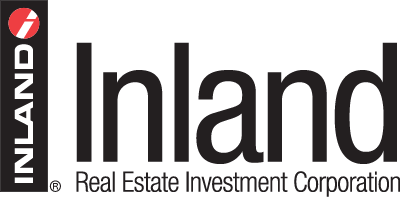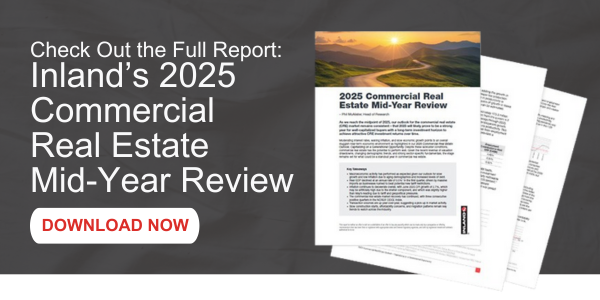As we enter the second half of 2025, our outlook for the commercial real estate market remains consistent -- 2025 will likely present compelling opportunities across various commercial real estate sectors.
Despite a sluggish near-term economic backdrop, marked by moderating interest rates, easing inflation, and tepid GDP growth, commercial real estate is showing signs of resilience thanks to strong sector-specific fundamentals.
Commercial Real Estate Outlook
The NCREIF ODCE Index has now posted three consecutive quarters of positive performance, rising 2.5% from its low.1 This sustained rebound follows a nearly 19% pullback driven by surging interest rates. As values begin to stabilize, the compelling entry point outlined in our 2025 outlook appears to be materializing. Historically, such brief corrections in high-quality real estate have presented opportunities for investors to capture returns by entering near the trough.
NFI-ODCE Index (Log Scale)1
Commercial Real Estate Outlook
Gross Domestic Product, Employment & Productivity
Both employment and productivity growth continue to face challenges. The country’s low birth rate and aging population suggest that even with a very low unemployment rate going forward, employment growth may only contribute approximately 0.3% to GDP, compared to the 0.8% contribution from 2008 to 2019.2 Productivity growth continues to experience a gradual decline, which is typical in aging nations with large debt loads, particularly when debt-to-GDP reaches somewhere between 75% and 100%.3 As of Q1 2025, the U.S. debt-to-GDP ratio stood at 121%.4
Net Domestic Income to U.S. GDP & Productivity Growth5

Given these factors, we expect real GDP growth to remain at 0.75% to 2.25% annually, with a midpoint of 1.50%.
Inflation & Interest Rates
As of June 2025, the Consumer Price Index (CPI) excluding shelter sits at 2.0%. Headline CPI continues its deceleration, reaching 2.7%, slightly higher than the prior months due to modest tariff and geopolitical pressures, particularly seen in food and energy prices.6 However, this number may be overstated due to how shelter costs are measured, as the shelter component lags actual changes in rent significantly. Removing it gives a clearer picture of real-time inflation. We expect headline CPI to remain low and decline further over time, despite volatility due to trade policy.
Interest rates at both the short end of the curve (controlled by the Federal Reserve) and the long end, driven by nominal GDP growth, will be impacted by these conditions. This is starting to unfold, with the 10-Year Treasury rate easing to around 4.4%, down from its January peak of 4.8%.7
10-Year Nominal GDP Growth & 10-Year U.S. Treasury8

We expect the Federal Reserve will likely cut rates further toward the end of the year as growth and inflation continue to show weakness. Over the long run, we expect long-term rates to track GDP growth, as can be seen in the chart above.
Strong Fundamentals Across High-Conviction Sectors
Residential
-
Strong rental demand persists as high home prices and interest rates make renting more attractive, especially for millennials forming households and baby boomers downsizing.
-
Supply is limited, with new residential starts declining due to rising construction costs and interest rates, setting the stage for potential rent growth as demand remains robust.9
-
Build-to-rent and manufactured housing community subsectors offer flexible, affordable living options tailored to millennials and baby boomers, combining privacy, community, and low-maintenance lifestyles that align with evolving demographic preferences.
Self-Storage
-
Storage rents are stabilizing after a post-pandemic surge and subsequent correction, with signs pointing to renewed growth in 2025 as new construction slows and demand rebounds.
-
Demographic shifts are fueling demand, with millennials forming households and baby boomers downsizing—both groups driving storage needs due to life transitions and limited space in rental housing.
-
We believe resilient demand and limited supply create favorable conditions for long-term growth, positioning self-storage as a compelling real estate sector in the second half of the year.10
Student Housing
-
Demand remains robust for premier educational institutions with strong academics and elite athletic conferences (Power 4) with enrollment growth roughly three times higher than non-power 4 schools.11
-
Preleasing, occupancy, and rent growth are thriving across top-tier universities compared to the rest of the student housing market.11
-
A combination of one degree-granting university closing each week on average in 202412 and the U.S. continuing to be a top destination for international students13 further bolsters our belief in the future success of the sector.
Healthcare (Medical Outpatient & Senior Housing)
-
We believe the rapid growth of Americans aged 65 and over will support the continued demand for both the medical outpatient building (MOB) and senior housing sectors.14
-
Strong fundamentals for MOB include rising occupancy rates, absorption outpacing income supply pipeline, and declining development starts – all fueled by a demographic shift from inpatient to outpatient care settings.15
-
Senior housing is driven by favorable demographic demand trends centered around the expansion of an aging population and a significantly limited supply.
With valuation declines reversing, demographic shifts reshaping demand, and strong demographic tailwinds among other factors, we believe the outlook for the commercial real estate market remains promising. These dynamics suggest that the second half of 2025 could be a defining period for the commercial real estate industry. We will continue to carefully watch these evolving trends to identify resilient strategies that have the potential to capture long-term value in an ever-changing economic landscape.
Sources:
1 NCREIF NFI-ODCE Index
2 Fred GDPC1
3 https://www.mercatus.org/research/policy-briefs/debt-and-growth-decade-studies#:~:text=Using%20the%20World%20Bank’s%20World,than%20the%2030%20percent%20level
4 U.S. Office of Management and Budget and Federal Reserve Bank of St. Louis, Federal Debt: Total Public Debt as Percent of Gross Domestic Product [GFDEGDQ188S], retrieved from FRED, Federal Reserve Bank of St. Louis; https://fred.stlouisfed.org/series/GFDEGDQ188S, June 12, 2025
5 FRED – Net Domestic Investment (W171RC1Q027SBEA) / GDP (GDP) & Labor Productivity (PRS85006092)
6 FRED CPI: Shelter (CUSR0000SAH1) & RealPage Effective Rent Growth YoY
7 U.S. Bureau of Economic Analysis, Gross Domestic Product [GDP], retrieved from FRED, Federal Reserve Bank of St. Louis; https://fred.stlouisfed.org/series/GDP, Board of Governors of the Federal Reserve System (US), Market Yield on U.S. Treasury Securities at 10-Year Constant Maturity, Quoted on an Investment Basis [DGS10], retrieved from FRED, Federal Reserve Bank of St. Louis; https://fred.stlouisfed.org/series/DGS10
8 FRED – Market Yield on U.S. Treasury Securities at 10-Year Constant Maturity, Quoted on an Investment Basis (GS10) & Gross Domestic Product (GDP)
9 Realpage Data Subscription
10 Green Street Advisors Data Subscription
11 RealPage Data Subscription
12 https://www.forbes.com/sites/markcperna/2025/01/28/new-data-reveals-the-depth-of-college-crisis/
13 https://www.kingseducation.com/kings-life/best-cities-for-international-students-in-usa
14 Worldbank.org – Population Estimates and Projections – 2024
15 JLL – 2025 Medical Outpatient Building Perspective; Healthcare Realty – Investor Presentation
Opinions expressed reflect the current opinions of Inland Real Estate Investment Corporation of the date appearing in the materials only and are based on Inland Real Estate Investment Corporation’s opinions of the current market environment, which is subject to change. Investors, financial professionals and prospective investors should not rely solely upon the information presented when making an investment decision and should review the most recent offering materials for the applicable investment program. Certain information contained in the materials discusses general market activity, industry or sector trends, or other broadbased economic, market or political conditions





